Bhushan B. Nanotribology and Nanomechanics: An Introduction
Подождите немного. Документ загружается.

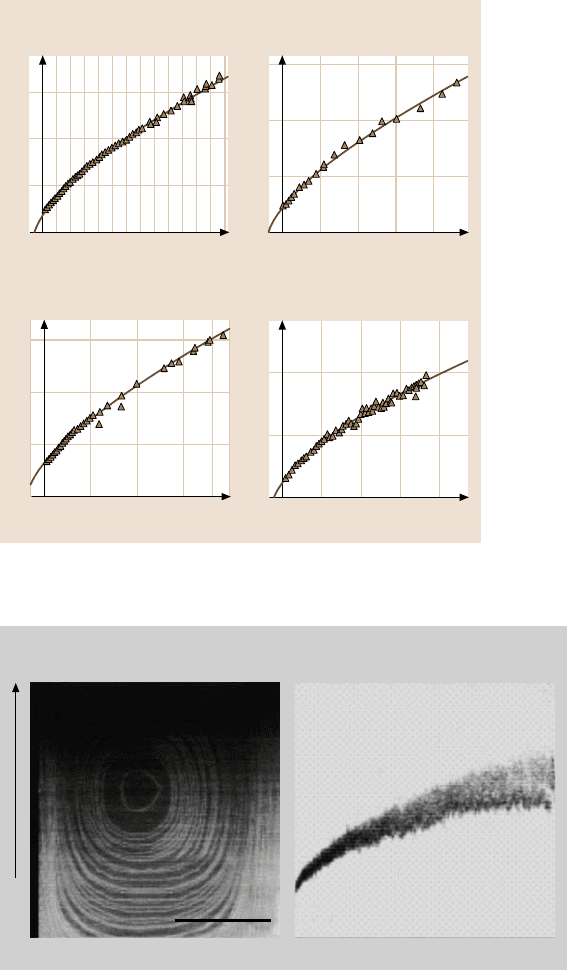
11 Friction and Wear on the Atomic Scale 585
b)
30
20
10
0
Normal force F
n
(nN)
100
Friction force (nN)
20 30 40
c)
30
20
10
0
Normal force F
n
(nN)
0
Friction force (nN)
10 20 30 40
d)
10
5
0
Normal force F
n
(nN)
50
Friction force (nN)
10 15 20
a)
6
4
2
0
Normal force F
n
(nN)
20
Friction force (nN)
4 6 8 10 12
Fig. 11.32. Friction versus load curve on amorphous carbon in argon atmosphere. Curves
(a)–(d) refer to tips with different radii of curvature. (After [65])
Decreasing normal load
F
F
(30nN)
1 000 nm
Friction force map
F
N
(130nN)
Steps
Terraces
a) b)
Fig. 11.33. (a) Friction force map on NaCl(100). The load is decreased from 140 to 0 nN
(jump-off point) during imaging. (b) 2-D-histogram of (a). (After [17])
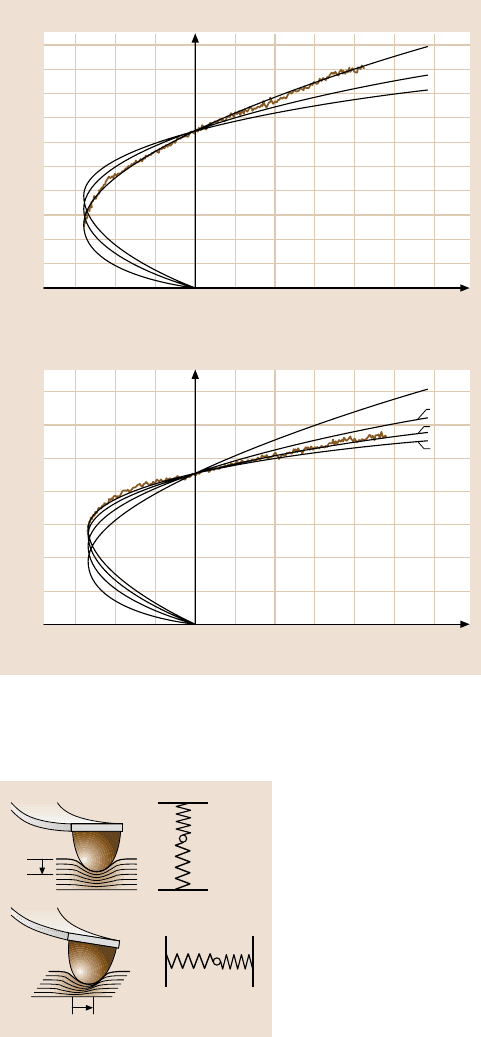
586 Enrico Gnecco et al.
z ~ r
2
z ~ r
4
z ~ r
6
z ~ r
2
z ~ r
4
z ~ r
6
z ~ r
8
500
400
300
200
100
200
Friction (nN)
a)
Load (nN)
3001000– 100
700
600
500
400
300
200
100
200
Friction (nN)
b)
Load (nN)
3001000– 100
Fig. 11.34. Friction versus load curves (a) for a spherical tip and (b) for a blunted tip. The
solid curves are determined using the JKR theory. (After [70])
k
lever
k
contact
k
lever
k
contact
Δz
Δx
=
=
Fig. 11.35. Sketch of normal and lateral stiffness
of the contact between tip and surface. (After [72])

11 Friction and Wear on the Atomic Scale 587
by contact stiffness measurements.The contact between the FFM tip and the sample
can be modeled by a series of two springs (Fig. 11.35).The effective constant k
z
eff
of
the series is given by
1
k
z
eff
=
1
k
z
contact
+
1
c
N
, (11.34)
where c
N
is the normal spring constant of the cantilever and k
z
contact
is the normal
stiffness of the contact. This quantity is related to the radius of the contact area (a)
by the simple relation
k
z
contact
= 2aE
∗
, (11.35)
where E
∗
is the effective Young’s modulus introduced previously [74]. Typical val-
ues of k
z
contact
are an order of magnitude larger than c
N
, however, and practical ap-
plication of (11.34) is not possible.
Carpick et al.independentlysuggestedan alternativemethod [72,75].According
to various models, the lateral contact stiffness of the contact between a sphere and
a flat surface is [76]
k
x
contact
= 8aG
∗
, (11.36)
where the effective shear stress G
∗
is defined by
1
G
∗
=
2−ν
2
1
G
1
+
2−ν
2
2
G
2
(11.37)
G
1
, G
2
are the shear moduli of the sphere and the plane, respectively. The contact
between the FFM tip and the sample can again be modeled by a series of springs
(Fig. 11.35). The effective constant k
x
eff
of the series is given by
1
k
x
eff
=
1
k
x
contact
+
1
k
x
tip
+
1
c
L
, (11.38)
where c
L
is the lateral spring constant of the cantilever and k
x
contact
is the lateral
stiffness of the contact. As suggested by Lantz, (11.38) also includes the lateral
stiffness of the tip, k
x
tip
, which can be comparable to the lateral spring constant. The
effectivespringconstant k
x
eff
is simply given bythe slope dF
L
/ dx of the friction loop
(Sect. 11.2.1). Once k
x
contact
is determined, the contact radius a is easily estimated
by (11.36).
The lateral stiffness method was applied to contacts between silicon nitride and
muscovite mica in air and between NbSe
2
and graphitein UHV. The dependencesof
both the spring constant k
x
eff
and the lateral force F
L
on the load F
N
were explained
within the same models (JKR and Maugis–Dugdale, respectively), which confirms
that friction is proportional to the contact area for the range of loads applied (up to
F
N
= 40 nN in both experiments).
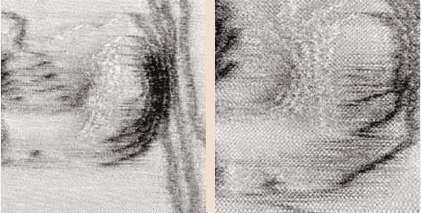
588 Enrico Gnecco et al.
Enachescu et al. estimated the contact area by measuring the contact conduc-
tance on diamondas a function of the applied load [77,78]. Their experimental data
were fitted with the DMT model, which was also used to explain the dependence of
friction on load. Since the contact conductance is proportional to the contact area,
the validity of the hypothesis (11.28) was confirmed again.
11.6 Wear on the Atomic Scale
If the normal force F
N
applied by the FFM exceeds a critical value, which depends
on the tip shape and on the material under investigation, the surface topography is
permanently modified. In some cases wear is exploited to create patterns with well-
defined shapes. Here we will focus on the mechanisms that act at the nanometer
scale, where recent experimentshave demonstrated the unique ability of the FFM to
both scratch and image surfaces down to the atomic scale.
11.6.1 Abrasive Wear on the Atomic Scale
Lüthi et al. observed the appearance of wear at very low loads, i.e. F
N
= 3nN,for
ionic crystals [32]. Atomically resolved images of the damage produced by scratch-
ing the FFM tip area on potassium bromide were obtained very recently by Gnecco
et al. [79]. In Fig. 11.36, a small mound that has piled up at the end of a groove
on KBr(100) is shown at different magnifications. The groove was created a few
minutes before imaging by repeatedly scanning with the normal force F
N
= 21nN.
The image shows a lateral force map acquired with a load of about 1 nN; no atomic
features were observed in the corresponding topographic signal. Figure 11.36a,b
shows that the debris extracted from the groove recrystallized with the same atomic
arrangement of the undamaged surface, which suggests that the wear process oc-
curred in a similar way to epitaxial growth, assisted by the microscope tip.
Although it is not that easy to understand how wear is initiated and how the
tip transports the debris, important indications are given by the profile of the lat-
eral force F
L
recorded while scratching. Figure 11.37 shows some friction loops
acquired when the tip was scanned laterally on areas of size 5 ×5nm
2
. The mean
lateral force multiplied by the scanned length gives the total energy dissipated in the
a) b)
Fig. 11.36. Lateral force
images acquired at the end
of a groove scratched 256
times with a normal force
F
N
= 21 nN. Frame sizes:
(a)39nm,(b)25nm
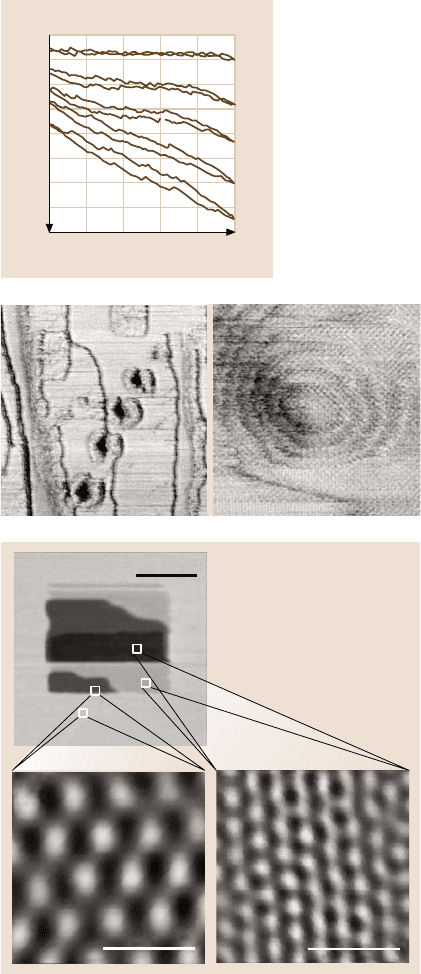
11 Friction and Wear on the Atomic Scale 589
F
L
(nN)
0
–10
–20
–30
–40
–50
–60
–70
–80
x (nm)
5
I
II
III
IV
V
43210
Fig. 11.37. Friction loops acquired while scratch-
ing the KBr surface on 5 nm long lines with differ-
ent loads F
N
= 5.7to22.8 nN. (After [79])
a) b)
Fig. 11.38. (a) Lateral force
images of the pits produced
with F
N
= 5.7to22.8nN.
Frame size: 150 nm; (b)
Detailed image of the fourth
pit from the top with pseudo-
atomic resolution. Frame
size: 20 nm
a)
b) c)
10 Å 10 Å
250 nm
10 Å
12 Å
10
Å
2 Å
2Å
Fig. 11.39. (a) Topography
image of an area scratched
on muscovite mica with
F
N
= 230 nN; (b),(c) Fourier-
filtered images of different
regions. (After [80])
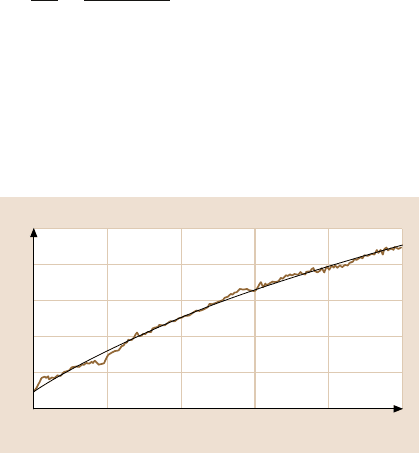
590 Enrico Gnecco et al.
process. The tip movement produces the pits shown in Fig. 11.38a. Thanks to the
pseudo-atomic resolution obtained by FFM (Fig. 11.38b), the number of removed
atoms can be determined from lateral force images, which allow us to estimate
that 70% of the dissipated energy went into wearless friction [79]. Figures 11.37
and 11.38 clearly show that the damage increases with increasing load. On the other
hand, changing the scan velocity v between 25 and 100nm/s did not produce any
significant variation in the wear process.
Adifferent kind of wear was observed on layered materials. Kopta et al. [80] re-
moved layers from a muscovite mica surface by scratching with normal force F
N
=
230nN (Fig. 11.39a). Fourier-filtered images acquired on very small areas revealed
the different periodicities of the underlying layers, which reflect the complex struc-
ture of the muscovite mica (Fig. 11.39b,c).
11.6.2 Contribution of Wear to Friction
The mean lateral force detected while scratching a KBr(100) surface with a fixed
load F
N
= 11nN is shown in Fig. 11.40. A rather continuous increase in “friction”
with the number of scratches N is observed, which can be approximated with the
following exponential law:
F
L
= F
0
e
−N/N
0
+ F
∞
1− e
−N/N
0
. (11.39)
Equation (11.39) is easily interpreted by assuming that friction is proportional
to contact area A(N), and that time evolution of A(N) can be described by
dA
dN
=
A
∞
−A(N)
N
0
. (11.40)
Here A
∞
is the limit area in which the applied load can be balanced without scratch-
ing.
To interpret their experiment on mica, Kopta et al. assumed that wear is initi-
ated by atomic defects. When the defects accumulate beyond a critical concentra-
tion, they grow to form the scars shown in Fig. 11.39. Such a process was once
10
8
6
4
2
0
Number of scratches (u 10
3
)
10
F
L
(nN)
2345
Fig. 11.40. Mean value of the
lateral force during repeated
scratching with F
N
= 11 nN
on a 500 nm line. (After [79])
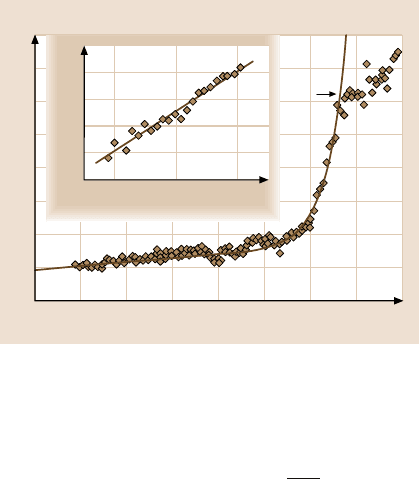
11 Friction and Wear on the Atomic Scale 591
Friction force (nN)
40
30
20
10
Total load (nm)
50 60 70 80 90
B
–6
–7
–8
–9
–10
–11
18.0 18.5 19.0
[L (nN)]
2/3
Fig. 11.41. Friction versus
load curve during the creation
of a hole in the muscovite
mica. (After [80])
again related to thermal activation. The number of defects created in the contact
area A(F
N
)is
N
def
(F
N
) = t
res
n
0
A(F
N
)f
0
exp
−
ΔE
k
B
T
, (11.41)
where t
res
is the residence time of the tip, n
0
is the surface density of atoms, and
f
0
is the frequency of attempts to overcome the energy barrier ΔE to break a Si
−
O
bond, which depends on the applied load. When the defect density reaches a critical
value, a hole is nucleated. The friction force during the creation of a hole was also
estimated via thermal activation by Kopta et al., who derived the formula
F
L
= c(F
N
−F
off
)
2/3
+ γF
2/3
N
exp
B
0
F
2/3
N
. (11.42)
The first term on the right gives the wearless dependence of friction in the Hertz-
plus-offset model (Sect. 11.5.1); the second term is the contribution of the defect
production. The agreement between (11.42) and experiment can be observed in
Fig. 11.41.
11.7 Molecular Dynamics Simulations
of Atomic Friction and Wear
Section 11.5 mentioned that small sliding contacts can be modeled by continuum
mechanics. This modeling has several limitations. The first and most obvious is
that continuum mechanics cannot account for atomic-scale processes like atomic
stick-slip. While this limit can be overcome by semiclassical descriptions like the
Tomlinson model, one definite limit is the determination of contact stiffness for con-
tacts with a radius of a few nanometers. Interpreting experimental results with the
592 Enrico Gnecco et al.
methods introduced in Sect. 11.5.3 regularly yields contact radii of atomic or even
smaller size, in clear contradiction to the minimal contact size given by adhesion
forces. Macroscopic quantities such as shear modulus or pressure fail to describe
the mechanical behavior of these contacts. Microscopic modeling that includes the
atomicstructureof thecontact isthereforerequired.This isusuallyachievedthrough
a molecular dynamics (MD) simulation of the contact. In such simulations, the slid-
ing contact is set up by boundaries of fixed atoms in relative motion and the atoms
of the contact, which are allowed to relax their positions according to interactions
between each pair of atoms. Methods of computer simulation used in tribology are
discussed elsewhere in this book.In this section we will discuss simulationsthat can
be directly compared to experimentalresults showing atomic friction processes. The
major outcome of the simulations beyondthe inclusion of the atomic structure is the
importance of including displacement of atoms in order to correctly predict forces.
Then we present simulation studies that include wear of the tip or the surface.
11.7.1 Molecular Dynamics Simulations of Friction Processes
The first experiments that exhibited the features of atomic friction were performed
on layered materials, often graphite. A theoretical study of forces between an
atomically sharp diamond tip and the graphite surface has been reported by Tang
et al. [81]. The authors found that the forces were significantly dependent on dis-
tance. The strongest contrasts appeared at different distances for normal and lateral
forces due to the strong displacement of surface atoms. The order of magnitude
found in this study was one nanonewton, much less than in most experimental re-
ports, which indicated that contact areas of far larger dimensions were realized in
such experiments. Tang et al. determined that the distance dependence of the forces
could even change the symmetrical appearance of the lateral forces observed. The
experimental situation has also been studied in numerical simulations using a sim-
plified one-atom potential for the tip–surface interaction but including the spring
potential of the probing force sensor [37]. The motivation for these studies was the
observation of a hexagonal pattern in the friction force, while the surface atoms of
graphite are ordered in a honeycomb structure. The simulations revealed how the
jump path of the tip under lateral force is dependent on the force constant of the
probing force sensor.
Surfaces of ionic crystals have become model systems for studies in atomic fric-
tion. Atomic stick-slip behavior has been observed by several groups with a lateral
force modulation of the order of 1nN. Pioneering work in atomistic simulation of
sliding contacts has been done by Landman et al. The first ionic system studied was
aCaF
2
tip sliding over a CaF
2
(111)surface [82].In MD calculationswith controlled
temperature, the tip was first moved toward the surface up to the point at which an
attractive normal force of −3nN acted on the tip. Then the tip was moved laterally,
and the lateral force determined. An oscillation with a periodicity corresponding to
the atomic periodicity of the surface and with an amplitude decreasing from 8nN
was found. Inspection of the atomic positions revealed a wear process from shear
cleavage of the tip. This transfer of atoms between tip and surface plays a crucial
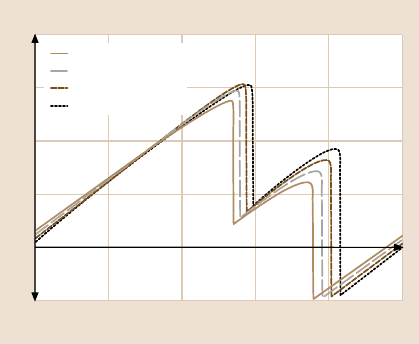
11 Friction and Wear on the Atomic Scale 593
role in atomic friction studies, as was shown by Shluger et al. [83]. These authors
simulated a MgO tip scanning laterally overa LiF(100) surface. Initially an irregular
oscillation of the system’s energy is found together with transfer of atoms between
surface and tip. After a while, the tip apex structure is changed by adsorption of
Li and F ions in such a way that nondestructive sliding with perfectly regular en-
ergy oscillations correlating with the periodicity of the surface was observed. The
authors called this effect self-lubrication and speculate that, in general, dynamic
self-organizationof the surface material on the tip might promote the observation of
periodic forces. In a less costly molecular mechanics study, in which the forces were
calculated for each fixed tip–sample configuration, Tang et al. produced lateral and
normal force maps for a diamond tip over a NaCl(100) surface, including such de-
fects as vacancies and a step [84]. As with the studies mentioned before, they found
that significant atomic force contrast can be expected for tip–sample distances of
less than 0.35nm, while distances below 0.15nm result in destructive forces. For
the idealized conditions of scanning at constant height in this regime, the authors
predict that even atomic-sized defects could be imaged. Experimentally, these con-
ditions cannot be stabilized in the static modes used so far in lateral force measure-
ments. However, dynamic modes of force microscopy have given atomic resolution
of defects within the distance regime of 0.2and0.4 nm [85]. Recent experimental
progress in atomic friction studies of surfaces of ionic crystals include the veloc-
ity dependence of lateral forces and atomic-scale wear processes. Such phenomena
are not yet accessible by MD studies: the experimental scanning timescale is too far
from the atomic relaxation timescales that govern MD simulations. Furthermore, the
number of freely transferable atoms that can be included in a simulation is simply
limited by meaningful calculation time.
Landman et al. also simulated a system of high reactivity, namely a silicon tip
sliding overa silicon surface [86]. A clear stick-slip variation in the lateral force was
observed for this situation. Strong atom displacements created an interstitial atom
Friction force (nN)
8
6
4
2
0
–2
Distance (Å)
0.0 0.5 1.0 2.0 2.51.5
<F
z
> = 9.2 nN
<F
z
> = 3.1 nN
<F
z
> = – 2.8 nN
<F
z
> = – 8.3 nN
Fig. 11.42. Lateral force act-
ing on a Cu(111) tip in match-
ing contact with a Cu(111)
substrate as a function of the
sliding distance at different
loads. (After [87])
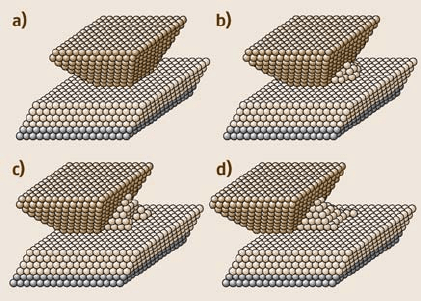
594 Enrico Gnecco et al.
Fig. 11.43. Snapshot of
a Cu(100) tip on a Cu(100)
substrate during sliding.
(a) Starting configuration;
(b)–(d) snapshots after two,
four, and six slips. (Af-
ter [87])
under the influence of the tip, which was annealed as the tip moved on. Permanent
damage was predicted, however, when the tip enters the repulsive force regime.
Although the simulated Si(111) surface is not experimentally accessible, it should
be mentioned that the tip had to be passivated by a Teflon layer on the Si(111)7×7
reconstructed surface before nondestructive contact mode measurements became
possible (Sect. 11.3). It is worth noting that the simulations for the Cu(111) surface
revealed a linear relation between contact area and mean lateral force, similar to
classical macroscopic laws.
Wear processes are predicted by several MD studies of metallic sliding over
metallic surfaces, which will be discussed in the following section. For a (111)-
terminated copper tip sliding over a Cu(111) surface, however,Sørensen et al. found
that nondestructive sliding is possible while the lateral force exhibits the sawtooth-
like shape characteristic of atomic stick-slip (Fig. 11.42). In contrast, a Cu(100)
surface would be disordered by a sliding contact (Fig. 11.43). This difference be-
tween the (100) and (111) plane (as well as the absolute lateral forces) has been
confirmed experimentally (Sect. 11.3).
11.7.2 Molecular Dynamics Simulations of Abrasive Wear
The long timescales characteristic of wear processes and the large amount of ma-
terial involved make any attempt to simulate these mechanisms on a computer
a tremendous challenge. Despite this, MD can provide useful insights on the mech-
anisms of removal and deposition of single atoms by the FFM tip, which is not
the kind of information directly observable experimentally. Complex processes like
abrasive wear and nanolithography can be investigated only within approximate
classical mechanics.
Theobservationmadeby LivshitsandShluger,thatthe FFM tipundergoesa pro-
cess of self-lubricationwhen scanning ionic surfaces (Sect. 11.7.1), provesthat fric-
tion and wear are strictly related phenomena. In their MD simulations on copper,
Sørensen et al. considered not only ordered (111)- and (100)-terminated tips, but
